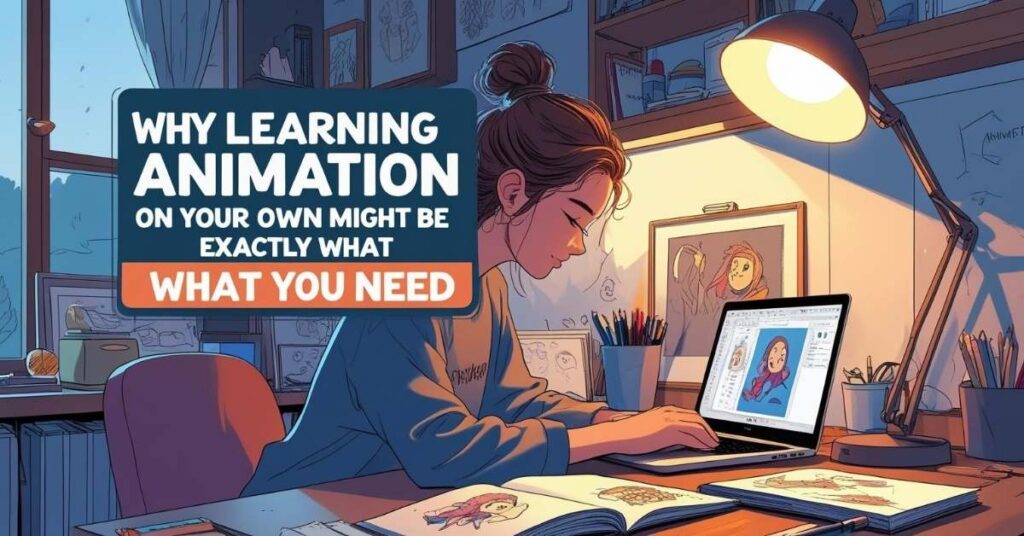In Part 1 of this series, we explored the advantages of taking animation courses—from structured learning to mentorship and accountability.

But here’s the truth: formal training isn’t the only path. And it’s definitely not the only path to success.
Some of the most creative animators, directors, and visual storytellers out there? Self-taught. Driven. Resourceful. And proof that there’s more than one way to grow.
In this post, we’ll walk through the benefits of teaching yourself animation, some honest challenges to be aware of, and a list of free and affordable tools you can start using today.
1. You Set the Pace (And the Curriculum)
When you’re self-taught, there are no grades, deadlines, or rigid structures. That freedom can be powerful.
- You learn when it fits your life
- You go deep into topics that interest you
- You skip what doesn’t serve you
Whether that means obsessing over timing arcs or experimenting with pixel art, you’re in full control of what you learn—and how fast.
2. You Learn How to Learn (Which Is a Superpower)
When you’re navigating things on your own, you develop a muscle that traditional training can’t always teach: resourcefulness.
You get better at:
- Breaking problems down
- Finding creative workarounds
- Teaching yourself new tools without fear
That independence will serve you not just as an animator, but as a lifelong creative.
3. You Save Money (Sometimes a Lot)
Let’s be honest: courses can be expensive. When you teach yourself, you’re often choosing the more affordable path.
That doesn’t mean you’re doing less—it just means you’re finding cleverer, cheaper ways to build the same skills.
4. You Build Real-World Creativity Muscles
Being self-taught means learning through trial and error. You make mistakes—and then you figure things out.
That process builds:
- Resilience
- Originality
- Creative confidence
It may take longer, and it might be harder at times, but it also makes you a problem-solver—and that’s priceless in animation.
Beginner Tools for the Self-Taught Animator

You don’t need fancy gear to start animating. Here’s a list of free or affordable tools and platforms that are perfect for beginners who want to learn on their own:
- FlipaClip – A mobile-friendly app that makes 2D animation fun and intuitive.
- Krita – A powerful free drawing and animation program perfect for frame-by-frame animation.
- OpenToonz – A free, open-source 2D animation tool used by professionals like Studio Ghibli.
- AnimationResources.org – Free lessons, reference material, and inspiration from classic animators.
- TipTut YouTube Channel – Animation and design tutorials for self-taught creatives, including After Effects and motion graphics.
- Bloop Animation Blog – Free tips, resources, and breakdowns even if you don’t take their courses.
YouTube, Reddit forums, and Discord communities can also be amazing support systems if you’re self-taught.
Final Thoughts: Your Path, Your Power
You don’t need a classroom to start animating. You need curiosity, persistence, and the courage to try—even when you’re unsure.
The self-taught path can be slower, but it’s also deeply personal. You learn by doing. You explore what excites you. And you build a voice that’s truly your own.
So whether you’re going solo by choice or by circumstance—know this:
You’re not behind. You’re building something real.
No matter how you learn, keep animating.
Source Material
- Part 1 of this series – Why Taking Animation Courses Can Fast-Track Your Skills
- FlipaClip – Beginner-friendly mobile animation app.
- Krita – Free open-source drawing & animation program.
- OpenToonz – Professional-grade open-source 2D animation software.
- Animation Resources – Free lessons & references from animation history.
- TipTut YouTube Channel – Tutorials for self-taught creatives.
- Bloop Animation Blog – Articles and tips for animators.
- Reddit r/animation – Active community for feedback, resources, and discussions.
- Reddit r/learnanimation – Beginner-focused subreddit for animation learners.
- Animation Discord Community – Real-time discussions, critiques, and peer support.
- Alan Becker Tutorials – Popular YouTube channel teaching animation basics.


























